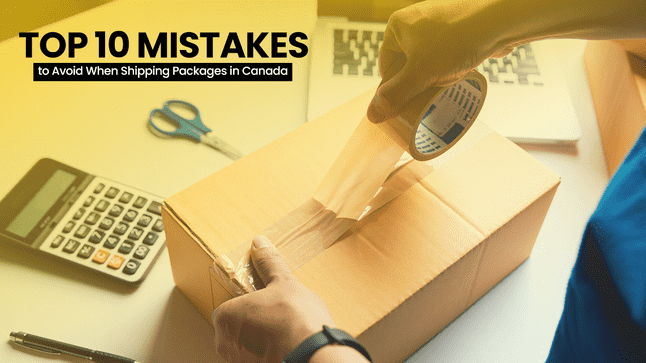ECommerce shipping in Canada is important for customer satisfaction and overall business growth. There are several important aspects of eCommerce shipping in Canada, and it can be sufficiently useful, yet perhaps confusing to sellers. Making mistakes with ecommerce shipping can easily result in costly delays, higher costs, a worse customer experience, and ultimately lead to a poor position in the marketplace.
Whether you are a small business, a startup, or an established retailer, avoiding common pitfalls with eCommerce shipping can help set you up for success.
In this blog, we will identify and expand upon the top 10 pitfalls you should avoid to optimize your eCommerce shipping in Canada, providing your customers seamless service from checkout to delivery.
10 Mistakes to Avoid in eCommerce Shipping in Canada

1. Not Researching the Right e-Commerce Shipping Solutions
One of the most critical errors sellers make is not properly researching and comparing available e-commerce shipping options. As a result of the size and scope of Canada’s geography and variations in delivery expectations, choosing carriers and shipping partners shouldn’t be a one-size-fits-all method.
Using a carrier or shipping partner without knowing their service areas and pricing and delivery timings can result in unexpected delays and extra costs.
Always evaluate carriers with your needs in mind. Some will have great options for shipping across Canada but won’t be good for heavier packages, while others will be good for urban areas and have faster same day delivery options.
2. Ignoring Shipping Costs In Pricing Strategy
Many sellers underestimate the effect shipping can have on pricing and profit margins. Many customers will leave their cart because the shipping fees seem high and unclear. To stay competitive, you should include shipping in your product price or offer free shipping after a certain amount.
Search for the cheapest ways to ship heavy items in Canada to reduce overhead. Negotiate with carriers or consider flat-rate shipping to keep the costs minimal for your customers.
3. Overlooking Packaging Efficiency
Efficient shipping means keeping packaging costs to a minimum. If you ship oversized boxes or use too much packing material, you are now paying for dimensional weight, which means additional fees. If you have insufficient packaging, you risk damaging goods during shipping.
Whether you ship small or large, invest time in finding the proper size and type of packaging materials for your unique products. These steps will help you keep shipping costs down while finding competitive, cheap delivery and not putting the product’s safety at risk.
4. Not Offering Multiple Shipping Options
Another mistake you should avoid in ecommerce shipping in Canada is limiting your store to just one shipping method, which could turn away buyers who are looking for faster and cheaper options.
It’s also worth noting that offering standard shipping in Canada will certainly increase customer satisfaction. Being upfront about when orders can be expected will strengthen customer trust as well.
5. Failing to Track Shipments Properly
Real-time tracking has become standard. For customers, shipment tracking eliminates anxiety and frustration, particularly if there is a delay. Concern about the status of a shipment means you can’t proactively address delivery problems.
Incorporate your shipping system with carrier-tracked tools to provide visibility. This procedure also supports your domestic shipping in Canada by providing more transparency.
6. Not Complying with Canadian Shipping Regulations
Shipping throughout Canada involves many areas of compliance, including customs declarations on cross-border sales and handling hazardous materials.
Another common mistake in ecommerce shipping in Canada is not complying with these regulations, which could result in delays or fines that harm your business’s reputation. You must be aware of all rules and regulations and compliance, especially when you offer international sales and retail shipments (i.e., third-party logistics).
7. Neglecting the Needs of Small Businesses
If you happen to be a small retailer, a thorough understanding of specialized small business shipping in Canada is critical. Large carriers often do not have the best pricing and flexibility for smaller quantities.
As your business grows, look for services designed specifically for small businesses that offer low pricing, simple integration, and custom solutions.
8. Skipping Insurance and Protection Plans
Shipping errors happen! If you neglect to insure an expensive or fragile item, you risk losing it and facing dire consequences. Insurance also builds customer confidence when buying high-ticket items.
Review each carrier’s insurance policies, and consider third-party insurance that meets your shipping profile.
9. Poorly Managing Returns and Exchanges
Returns are inevitable in ecommerce delivery, but a poor returns process can frustrate customers and increase operational costs.
To avoid any mistakes in ecommerce shipping in Canada, create a clear, hassle-free return policy and streamline logistics for reverse shipping. Such an approach will reduce disputes and enhance your brand image.
10. Forgetting About the Importance of Customer Communication
Lack of communication is one of the common issues in online shopping. Failing to inform customers about shipping status, delays, or delivery confirmation can cause disruptions.
To avoid mistakes in ecommerce shipping in Canada, automate email or SMS notifications for every stage of the shipping journey. Effective communication is the key to the delivery and shipping services in Canada.
Conclusion
Optimizing ecommerce shipping in Canada needs a comprehensive approach, from selecting the right ecommerce shipping solutions to managing packaging, tracking, and customer communication. By avoiding such mistakes, you can increase operational efficiency, reduce costs, and, most importantly, provide your customers with a trusted and enjoyable shopping experience.
Remember to explore competitive options for affordable delivery and find the cheapest ways to ship items in Canada that fit your business. Whether you are providing standard shipping in Canada, same-day delivery, or specialized business shipping services in Canada, prioritizing the customer journey will set you apart in the Canadian market.





